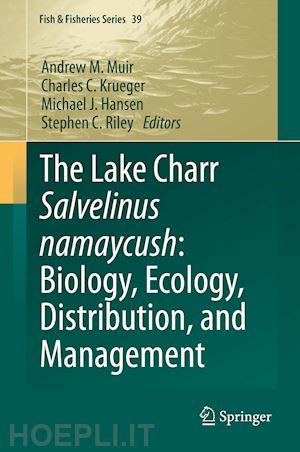
Questo prodotto usufruisce delle SPEDIZIONI GRATIS
selezionando l'opzione Corriere Veloce in fase di ordine.
Pagabile anche con Carta della cultura giovani e del merito, 18App Bonus Cultura e Carta del Docente
The lake charr Salvelinus namaycush is a ubiquitous member of cold-water lake ecosystems in previously glaciated regions of northern continental U.S., Alaska, and Canada that often support important commercial, recreational, and subsistence fisheries. The lake charr differs from other charrs by its large size, longevity, iteroparity, top-predator specialization, reduced sexual dimorphism, prevalence of lacustrine spawning, and use of deepwater habitat. The species is remarkably variable in phenotype, physiology, and life history, some of which is reflected in its ecology and genetics, with as many as four morphs or ecotypes co-occurring in a single lake. The lake charr is often the top predator in these systems, but is highly adaptable trophically, and is frequently planktivorous in small lakes. The lake charr by their name highlights their common habitat, lakes both large and small, but often frequents rivers and occasionally moves into the Arctic Ocean. Movement and behaviour of lake charr are motivated by access to cool, well-oxygenated water, foraging opportunities, predator avoidance, and reproduction. Owing to their broad distribution and trophic level, the lake charr serves as a sentinel of anthropogenic change. This volume will provide an up-to-date summary of what is currently known about lake charr from distribution to genetics to physiology to ecology.
The book provides a compilation and synthesis of available information on the lake charr, beginning with an updated distribution and a revised treatment of the paleoecology of the species. Understanding of ecological and genetic diversity and movement and behaviour of the species has advanced remarkably since the last major synthesis on the species over 40 years ago. Mid-sections of the book provide detailed accounts of the biology and life history of the species, and later sections are devoted to threats to conservation and fishery management practices usedto ensure sustainability. A new standard lake charr-specific terminology is also presented. The book will be a valuable reference text for biologists around the world, ecologists, and fishery managers, and of interest to the angling public.Introduction. The Lake Charr: Biology, Ecology, Distribution, and Management.- Distribution.- Paleoecology.- Ecological Diversity.- Genetic Diversity.- Habitat.- Movement Ecology and Behavior.- Life History and Population Dynamics.- Trophic Ecology.- Reproduction.- Contaminants and Ecotoxicology.- A General, Life History Based Model for Sustainable Exploitation of Lake Charr across their Range.- Terminology Issues in Lake Charr Early Development.
Stephen Riley recently retired from the U. S. Geological Survey Great Lakes Science Center in Ann Arbor, Michigan, where he served as a research fishery biologist. Stephen earned a B.Sc. (1984) and M.Sc. (1986) in Biology from the University of Waterloo and a Ph.D. in Fishery and Wildlife Biology from Colorado State University (1992). He has conducted research on salmonid ecology and management throughout North America.
Dr. Charles “Chuck” Krueger is the T.F. Waters Professor of Aquatic Ecology and Conservation at Michigan State University, and former Director of the Great Lakes Acoustic Telemetry Observation System. In addition, he has worked for the Wisconsin Department of Natural Resources, U.S. Fish and Wildlife Service, Great Lakes Fishery Commission, and Cornell University. He is keenly interested in discovering the ecological characteristics of fish species of conservation concern and linking those results to their restoration, conservation, and wise use in fisheries. The discovery process is made through a variety of disciplines including investigating morphology, trophic ecology, behavior, and population genetics.











Il sito utilizza cookie ed altri strumenti di tracciamento che raccolgono informazioni dal dispositivo dell’utente. Oltre ai cookie tecnici ed analitici aggregati, strettamente necessari per il funzionamento di questo sito web, previo consenso dell’utente possono essere installati cookie di profilazione e marketing e cookie dei social media. Cliccando su “Accetto tutti i cookie” saranno attivate tutte le categorie di cookie. Per accettare solo deterninate categorie di cookie, cliccare invece su “Impostazioni cookie”. Chiudendo il banner o continuando a navigare saranno installati solo cookie tecnici. Per maggiori dettagli, consultare la Cookie Policy.